Diesel Average Tops $4 After Fifth Straight Gain
This story appears in the March 3 print edition of Transport Topics.
The U.S. diesel average pushed past the $4 level for the first time in almost a year, gaining 2.8 cents to $4.017 a gallon, the Department of Energy reported Feb. 24.
Trucking’s main fuel, which has risen 14.4 cents over the past five weeks, last topped $4 on March 25.
Despite the gain, diesel was 14.2 cents less than in the same week a year ago, DOE said after its Feb. 24 survey of filling stations.
The agency also reported the retail gasoline average price jumped 6.4 cents to $3.444 a gallon, the highest price in five months.
The fuel — which has posted three straight gains — spiked 13.5 cents in the two most recent weeks, the sharpest such rise since mid-July, when it rose almost 20 cents.
Last week’s price is 34 cents below a year ago, but the highest since it was $3.495 on Sept. 23.
The upturns came on the heels of oil prices that topped $102 a barrel, the highest level since October.
One analyst said the winter’s ongoing cold weather, coupled with seasonal refinery maintenance issues and higher oil prices, combined to boost pump prices higher.
“Nobody really thought we’d be up there at $4, but the weather has thrown everyone for a loop,” said Phil Flynn, senior market analyst with Price Futures Group in Chicago. “We’ve had refinery issues and supply issues. The good news is, someday it might warm up.”
In contrast to recent weeks, last week’s diesel upturns were led by gains in DOE’s West Coast and Rocky Mountain regions, where it rose more than 3 cents each to $4.035 and $3.95 per gallon, respectively.
The East Coast’s price rose 1.9 cents to $4.148 — remaining the highest regional average — and its New England and Central Atlantic subregions continued to have the highest overall prices at $4.386 and $4.358.
Prices in those areas — led largely by the winter’s frigid temperatures that put high demand on heating oil — had jumped more than 25 cents in the previous month.
Diesel imports into the Northeast from Europe helped slow the recent price spikes in that area, Flynn told Transport Topics. He noted the national average is below a year ago when it peaked at $4.159 — the highest since the record-setting summer of 2008.
“That’s the silver lining,” Flynn said, adding that distillate supplies are 60% below the five-year average price at this time of year, another factor that’s helped pushed prices up.
One carrier based in Washington state said he had seen diesel top $5 in some areas of California.
Prices have topped $5 in both the San Francisco and Los Angeles areas, and “They’re dancing right at the $5 mark” in other areas, said Brian Schuster, CEO of West Coast Carriers in Port Orchard, Wash.
“We’ve seen anywhere from 3- to 12-cent increases recently, and California is obviously even higher,” Schuster said Feb. 26. “It’s been higher lately than what we normally pay, [and] prices are all over the board. We don’t see any consistency.”
To help rein in costs, the refrigerated carrier, which operates across the country, limits its idling, maintains optimum tire pressure and has its drivers max out their loads at 43,000 pounds.
“Anything more than that and you start going backwards in your miles per gallon,” Schuster told TT.
In a separate report last week, DOE said supplies of distillate fuel, which includes diesel and home heating oil, rose by 340,000 barrels, though they fell by 52,000 barrels on the East Coast.
Gasoline inventories dropped 2.8 million barrels, while crude oil supplies rose 68,000 barrels, the sixth straight gain.
Crude — which pushed past the $100 mark in mid-February for the first time since October — has been rising on concern over political unrest in Venezuela, a major oil supplier, and lower supplies at Cushing, Okla., a major U.S. oil hub, Flynn said.
Oil finished the Feb. 27 trading day at $102.40 a barrel, Bloomberg reported.




